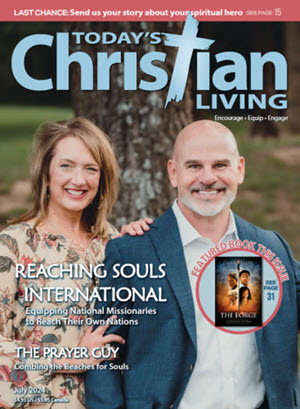By Tim Bennett
Terminally ill patients who want to commit suicide are finding it increasingly easy to carry out their wishes. In June 1997, the U.S. Supreme Court ruled unanimously that physician-assisted suicide was not a constitutional right, thus leaving the issue to state legislatures to decide. Taking advantage of this opening, activists are aggressively pursuing grassroots support, contacting politicians, raising funds, and holding events and rallies to pass bills in all 50 states that will allow doctors to prescribe death-inducing drugs to their patients — and they’re making progress.
Ostensibly, in the name of compassion, as well as preserving dignity and individual rights, non-profit political organizations such as Compassion & Choice (formerly known as the Hemlock Society) and the Death With Dignity National Center are relentlessly pushing a pro-death agenda.
Since Oregon passed its Death with Dignity Act in 1997, eight other states have followed suit (California, Colorado, Montana, Vermont, Washington State, Hawaii, New Jersey, and Maine) as well as the District of Columbia. In fact, three of the states that passed bills did so in the last 15 months, so momentum is building. According to the Death With Dignity website, 17 states (Arizona, Connecticut, Florida, Georgia, Indiana, Iowa, Kentucky, Maryland, Massachusetts, Minnesota, New Hampshire, New York, Pennsylvania, Rhode Island, Utah, Virginia, and Wisconsin) are considering the legislation in 2020.
The Difference Between Euthanasia and Physician-Assisted Suicide
Euthanasia, known as “voluntary active euthanasia” (VAE), requires a doctor to actively administer the lethal drugs. Physician-assisted suicide (PAS), on the other hand, allows doctors to prescribe the lethal drugs, but patients have to take it themselves. VAE is legal in Canada, Colombia, and some European countries such as the Netherlands, Belgium, and Luxembourg (1). But in the United States, PAS is the only legal option, and even then, not in every state.
Currently, to qualify for PAS in the U.S., in those states that allow it, a waiting period may be required, and a person must be:
• terminally ill and have less than six months to live, with two doctors confirming this diagnosis
• an adult resident in the state in which death is to occur
• mentally competent
• able to self-administer and ingest the drugs on his or her own
Opposition From the American Medical Association
The Death with Dignity movement isn’t without opponents in the medical community, however. In fact, as recently as June 2019, the American Medical Association (AMA) condemned the practice by a vote of 360–190 (bit.ly/AMA-PAS-Vote). AMA’s official statement is that “physician-assisted suicide is fundamentally incompatible with the physician’s role as healer, would be difficult or impossible to control, and would pose serious societal risks” (bit.ly/AMA-PAS-policy).
Advocates of the PAS bills make suicide sound appealing by avoiding the term “physician-assisted suicide” in proposed legislation. Instead, they use softer terms like “Medical Aid in Dying,” “End of Life Options,” or “Death with Dignity.” The Council on Ethical and Judicial Affairs (CEJA), which is a part of the AMA, reported that “Proponents of physician participation often use language that casts the practice in a positive light,” a distortion that the AMA opposes (bit.ly/CEJAStatement). To date, AMA rejects euphemisms in favor of the more specific and blunt term “physician-assisted suicide.”
A Christian Physician’s Perspective
Dr. Kathryn Butler, author of Between Life and Death: A Gospel-Centered Guide to End-of-Life Medical Care (Crossway 2019), agrees with the CEJA that the change in terminology of the practice is confusing to the public. She said in a recent telephone interview, “When you change the language from ‘physician-assisted suicide’ to ‘medical aid in dying’ you could be talking about hospice care (2), and that is not the same thing. With physician-assisted suicide, you’re ending your life prematurely, intentionally. With medical aid in dying, you’re saying, ‘Okay. I have a terminal disease. I’m not going to be able to cure it. I’m dying. I’m going to focus on making my days more fulfilling, more comfortable. I’m not trying to speed up my demise.’” In her book, Dr. Butler emphasizes the difference between allowing someone to die — when prolonged medical technology is futile — and killing them.
In commenting on society’s gradual acceptance of PAS, Dr. Butler said, “I think there has been a frame shift in the understanding of who has the authority over life and death. The Christian says, ‘God does.’ The secular mindset says, ‘It’s the individual.’ It begins and ends with my autonomy, my individualism — so I have the right to do it.”
In Between Life and Death, Butler wrote, “The emergence of PAS in courtrooms and clinics signals our failure as a society to support the dying, particularly as illness disables us. The most common reason that people cite for pursuing PAS is not intractable pain, but rather loss of independence. A review of data in Oregon from 1998 to 2016 revealed that 79 to 92 percent of people who committed suicide with physician assistance cited loss of autonomy, inability to engage in activities that make life enjoyable, and loss of dignity as their motivations for ending life…These alarming statistics suggest not a solution in PAS but rather a gross failure on the part of American society to uplift people with progressive and debilitating illness” (pg. 145).
Fatal Flaws: Uncovering Perspectives on Euthanasia Around the World
In the 2018 documentary Fatal Flaws (fatalflawsfilm.com), Canadian filmmaker Kevin Dunn travels to pro-euthanasia and physician-assisted suicide states and countries to speak with people on both sides of the issue. He observed in the Netherlands (called “the capital of euthanasia in the world”) that since 2002, when legalization of euthanasia opened the door for patients with “unbearable suffering without the hope of improvement,” the laws have gone down a “slippery slope.” They now include those with dementia (people who commit to be euthanized legally in writing while they’re still mentally competent) and those with psychiatric suffering. And under the Completed Life Act (not yet passed), the laws may soon include people over 75 who feel they’ve lived “completed lives.”
One man Dunn interviewed in his film was Professor Theo Boer from the Protestant Theological University in Groningen, the Netherlands, who was part of the country’s regulatory body for euthanasia from 2005 to 2014. Although Boer originally supported the first bill legally allowing euthanasia in his country, Boer now thinks the laws have gone too far. “We’re getting used to euthanasia,” he said. “That’s exactly what should not happen. We’re no longer speaking about the exceptional situations that the law was created for, but a gradual process towards organized death.”
Probably the most troubling parts of the documentary Fatal Flaws are the interviews with people who were actually encouraged to consider PAS by their doctors without asking for it. William Peace, Ph.D., a professor of anthropology in Colorado and an advocate for the disabled, said a doctor had come to him when he was in the hospital, in the middle of the night, and asked, “Do you know how sick you are?” Peace replied, “Yes,” and then the physician went down a laundry list of what could happen to him: he would probably go bankrupt with all the medical expenses; he may not ever sit up again; he may not be able to work again. Peace said, “He was very politely asking me if I wanted to die, and he would make it happen.”
In another case, in St. Anthony, Newfoundland, Canada, a woman named Sheila Elson told Dunn that when her daughter Candace, who has cerebral palsy and seizures, went to the hospital, a doctor took Candace into the hallway and told her to abandon hope. He even accused her of being selfish for not considering other alternatives. When Sheila heard the doctor asking her daughter face to face, “Do you know how sick you are?,” she knew what was going on and told him to get out.
A Short Step Away From Involuntary Euthanasia
Experiences like Peace’s and the Elsons’ should serve as red flags that VAE and PAS could be a short step away from physicians committing involuntary euthanasia, fully convinced that some of their patients, in their opinion, do not have lives worth living.
Wesley Smith, the attorney for the International Anti-Euthanasia Task Force, wrote a Dec. 17, 2000, op-ed “We Ignore the Dutch Legalization of Euthanasia at Our Own Peril” (euthanasia.com/nethcases.html). In the article, he warned that involuntary euthanasia would take place if the U.S. opened its doors to physician-assisted suicide based on what was already happening in the Netherlands. He said that a Dutch study showed that, in 1990 in the Netherlands, more than 1,000 cases of euthanasia were conducted “without an explicit request.” And in 4,941 other cases, doctors gave “lethal morphine overdoses without the patients’ explicit consent.” So in 1990, around 4% of Dutch deaths were the result of involuntarily euthanasia.
U.S. Polls Show Widespread Acceptance of Euthanasia
Despite the warnings against euthanasia and physician-assisted suicide from certain sectors, however, according to a Gallup poll in May 2018, 72% of adult respondents in the United States said “yes” to this question: “When a person has a disease that cannot be cured, do you think doctors should be allowed by law to end the patient’s life by some painless means if the patient and his or her family request it?”
A Missing Piece of Information
This Gallup poll, with a 95% confidence level, indicates that a majority of the adult population of the United States now favors this practice. Surprised by this, I contacted Dr. Cheryl Morrow — a physician who has been working with dying patients in nursing homes for 19 years in New York State and as a lobbyist against the upcoming bills in her state. I asked her, “Why do you think so many Americans seem to be for physician-assisted suicide? Is there something they’re missing?”
Dr. Morrow replied, “One of the things they may be missing is that we can control pain. People are being told that patients have excruciating pain and we are not able to control it, so the only option we have is to kill them. Our motto as physicians against PAS is “kill the pain not the patient.” In New York State, we have the second lowest referral rate to hospice in the country. This means that patients are not accessing good pain management at the end of life.”
In a phone interview, Dr. James Mostram, an anesthesiologist from Fayetteville, New York, highlighted another important point. “Doctors also do not always accurately predict how long a patient will live. In fact, 20% of people who go into the hospice program leave it because they’ve outlived their diagnosis” he explained. Dr. Mostram was particularly troubled that data from Oregon showed that only 2% of the people seeking PAS received psychiatric referrals from their doctors. “Most people who face a fatal diagnosis are depressed about this and a lot of psychiatric issues can be treated,” he said.
When I asked Dr. Morrow about the benefits of waiting to die naturally rather than participating in PAS, she said, “As a Christian and a physician, I’ve seen good things come out of the end-of-life experience. I’ve seen many of my patients turn to their Creator and I’ve led a lot of patients to the Lord on their deathbeds. Unfortunately, many people are not open to God until they’re faced with the question, “Where am I going to go after I die?” Families also have time to reconcile, which can’t happen if someone dies in a car accident or the time is cut short.
“Scripture also talks about the comfort God gives us in our suffering and how we can pass that on to someone else. People who have cancer, for example, can sometimes minister to others with cancer much better than I can just because they’re experiencing the same thing as the other person and I’m not. Something I often say to my patients is that God does not put down His tools until He’s finished with them. And if you’re still here, God still has work for you to do.”
1 See the complete list at Wikipedia Legality of Euthanasia (bit.ly/Legality-of-Euthanasia).
2 Hospice care is a type of health care that focuses on the palliation of a terminally ill patient’s pain and symptoms and attending to their emotional and spiritual needs. Usually, it is used for people with no further options for curing their disease or in people who have decided not to pursue further options that are arduous, likely to cause more symptoms, and not likely to succeed.
Tim Bennett is a regular contributor to moviesandmemoirs.org and is the author of Runaways, a suspense story based on his own life and experiences in France where he worked for Youth With A Mission (YWAM) for 10 years.









